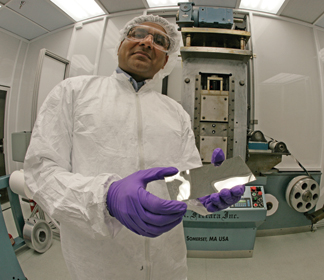Jan 17 2013
A technology invented at the Department of Energy's Oak Ridge National Laboratory for manufacturing copper-oxide based high-temperature superconducting materials has been used to make an iron-based superconducting wire capable of carrying very high electrical currents under exceptionally high magnetic fields.
 ORNL researcher Amit Goyal with a RABiTS sample.
ORNL researcher Amit Goyal with a RABiTS sample.
Researchers at Brookhaven National Laboratory took a RABiTS, or rolling-assisted biaxially textured substrate, comprised of a nickel-tungsten metal alloy with hetereoepitaxial buffer layers of Y2O3, YSZ, CeO2 and epitaxially deposited an iron-based high-temperature superconducting layer. The work was published on-line Jan. 8 in the journal Nature Communications.
The single-crystal-like RABiTS were developed in the 1990s by an ORNL team led by Corporate Fellow and Battelle Distinguished Inventor Amit Goyal. Iron-based high-temperature superconductors are a relatively recent discovery; many of the previous high-temperature superconductors were copper-based.
The iron-based superconductors can be synthesized at lower temperatures than the copper-oxide materials, and hence are seen as easier to work with. Brookhaven's experiment used RABiTS with a cerium oxide top layer.
The iron-based superconducting films deposited on the cerium oxide coated RABiTS exhibited significantly higher critical currents than could be previously obtained. "The high critical current density was realized because grain boundaries in the RABiTS substrate are all less than about seven to eight degrees in total misorientation angle. Recent work on bicrystal grain boundaries in iron-based superconductors shows that the critical misorientation angle where the current density drops is around nine degrees," Goyal said.
"The RABiTS substrate can be further modified into a very simple and low-cost substrate for fabrication of iron-based superconducting wires, and we hope to demonstrate this in the near future," he said.
ORNL's RABiTS technology has received several awards and is licensed for the commercial production of long lengths of flexible copper-oxide based high-temperature superconducting wire which is a critical energy efficiency technology due to its ability to conduct electricity with practically no resistance or loss.
The work at Oak Ridge National Laboratory was supported by DOE's Office of Electricity Delivery and Energy Reliability, the work at Brookhaven Lab was funded by the DOE's Office of Science. Portions of the work were also carried out at the National High Magnetic Field Laboratory, which is supported by the National Science Foundation.